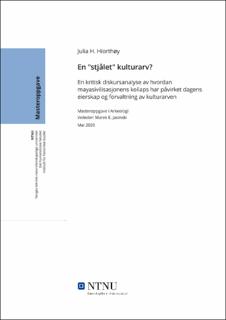| dc.contributor.advisor | Jasinski, Marek E. | |
| dc.contributor.advisor | Brattli, Terje | |
| dc.contributor.author | Hiorthøy, Julia H. | |
| dc.date.accessioned | 2021-09-13T16:03:55Z | |
| dc.date.available | 2021-09-13T16:03:55Z | |
| dc.date.issued | 2020 | |
| dc.identifier | no.ntnu:inspera:58319055:3301659 | |
| dc.identifier.uri | https://hdl.handle.net/11250/2775549 | |
| dc.description.abstract | Denne oppgaven tar for seg hvordan mayasivilisasjonens kollaps og reorganisering har påvirket dagens eierskap og forvaltning av den materielle kulturarven. Til tross for at den forhistoriske mayasivilisasjonen omtales som kollapset, er ikke mayaene et forsvunnet folk. Mayaene er i dag en urbefolkning som utgjør minst syv millioner mennesker. Majoriteten av denne befolkningsgruppen er i stor grad preget av både fattigdom og marginalisering. De har få eller ingen rettigheter knyttet til sin egen kulturarv. En kollaps av tidligere samfunnsstrukturer kan ha ført til et brudd i kontinuitet mellom forhistoriens maya, historiens maya og nåtidens maya. Dette kan ha påvirket deres rolle i den moderne kulturminneforvaltningen.
Oppgavens problemstillinger er som følger: (1) Når kollapset mayasivilisasjonen, og hva var de utløsende årsakene?, (2) Hvordan reorganiserte mayasivilisasjonen seg etter kollapsen?, og (3) Hva slags betydning har mayasivilisasjonens kollaps for dagens eierskap og forvaltning av den materielle kulturarven, og hvordan påvirker dette den moderne mayabefolkningen?
Ved å bruke den sosial-økologiske systemteorien og en kritisk diskursanalyse, skal oppgaven undersøke hvordan hendelser i fortiden har påvirket hvordan vi identifiserer, tolker, verdsetter, forvalter og bruker den materielle kulturarven i nåtiden. | |
| dc.description.abstract | This thesis will address what significance the Maya civilization’s collapse and reorganization has on today’s ownership and management of the material cultural heritage. The Maya civilization is considered to have collapsed, but the Mayans are not a lost people. Today the Mayans are an indigenous group of at least seven million people. The majority of this population is largely characterized by poverty and marginalization. They have few or no rights to their own material cultural heritage. A collapse of past social structures may have led to a breach of continuity between the prehistoric Maya, the historic Maya and the present Maya. This may have influenced their role in the modern cultural heritage management.
The thesis’ research questions are as following: (1) When did the Maya civilization collapse, and what were the causes?, (2) How did the Maya civilization reorganize after the collapse?, and (3) What is the significance of the collapse of the Mayan civilization for today’s ownership and management of the material cultural heritage, and how does this affect the modern Maya population?
Using socio-ecological systems (SES) and a critical discourse analysis (CDA), this thesis will examine how events in the past have influenced how we identify, interpret, value, manage and use the material cultural heritage in the present. | |
| dc.language | | |
| dc.publisher | NTNU | |
| dc.title | En "stjålet" kulturarv? | |
| dc.type | Master thesis | |
